 Fresh out of Japan is the new Caplio R5 digital camera, featuring anti-shake, a new 7.24 megapixel CCD and the same mighty 7.1x optical wide zoom lens (28-200mm, 35mm equiv) as seen on its predecessor, the Caplio R4 ( reviewed here in April 2006).
Fresh out of Japan is the new Caplio R5 digital camera, featuring anti-shake, a new 7.24 megapixel CCD and the same mighty 7.1x optical wide zoom lens (28-200mm, 35mm equiv) as seen on its predecessor, the Caplio R4 ( reviewed here in April 2006).
Ricoh are making big claims for the low light capabilities of their new image processing engine, which works with the built in CCD-shift vibration correction method to produce what they describe as, “high quality images at even higher ISO settings with low noise.”
The new model looks very similar to the R4, but there’s been a few changes in the physical layout: the anti-shake on/off button from the top plate has now disappeared into a sub-menu accessible from the LCD interface, with a circular on/off button taking its place.
 We can’t say we liked this move, as the smaller, recessed power button is much harder to operate (we also had issues with powering up the camera, but we’ll move on to that later).
We can’t say we liked this move, as the smaller, recessed power button is much harder to operate (we also had issues with powering up the camera, but we’ll move on to that later).
Sneaking around the back
The buttons on the rear of the camera have been shunted around a bit too, with the zoom rocker also getting that shrinking feeling while being moved closer to the LCD screen.
We really can’t work out the thinking behind this move. The new, smaller zoom control is much harder to operate and if you were wearing gloves, zooming would be nigh-on impossible.
The small three-way camera/screen/movie switch also remains as fiddly as with the R4, although Ricoh’s designers have seen fit to move it to the right hand side of the camera.
 LCD screen
LCD screen
There’s still a healthily large 2.5-inch LCD dominating the back of the camera.
This has been ramped up from 150k to 230k pixels although the difference didn’t seem as stunning as we might have hoped.
A quick caveat here: we ended up going into a camera store and asking them to get out a R4 for comparison.
While holding out both cameras pointing at the same scene we have to say there didn’t seem a huge amount of difference – sure, the R5 seemed a bit smoother, but none of the waiting customers managed to guess which screen was the newer one.
 Seeing as the assistant was most unimpressed with our antics we had to cut short our testing, so we can only assume that the differences would manifest themselves under more demanding light conditions or under closer scrutiny.
Seeing as the assistant was most unimpressed with our antics we had to cut short our testing, so we can only assume that the differences would manifest themselves under more demanding light conditions or under closer scrutiny.
With all those extra pixels, the screen has to be better so maybe we were all on drugs or something.
Daytime shooting
Like Dracula in reverse, this camera works best when the sun is in the sky.
Taking the R5 out for a stroll around London, we were pleased by its fast power-up times and were constantly reminded of the benefits of having a compact with a proper wide-angle zoom range.
 The LCD screen was easy to read (although, being London in September, the sun wasn’t exactly blinding), but we would have liked to have seen an optical viewfinder in there too.
The LCD screen was easy to read (although, being London in September, the sun wasn’t exactly blinding), but we would have liked to have seen an optical viewfinder in there too.
Although suffering from a rather noisy zooming mechanism, the R5 took crisp and pleasing daytime shots, with exposure generally spot on and images exposed at 64 and 100 ISO showing very little noise.
The banding issues that plagued the R4 were also noticeable by their absence too.
The new 640 x 480/30fps movie mode was fun, and produced some smooth clips, although the juddery digital zoom is best left alone (like most digicams, the optical zoom is deactivated when shooting in movie mode).
 Night time woes
Night time woes
We were disappointed with the camera’s night time performance.
Purely in the interests of ensuring a full test, we took the camera out to a Brixton club and grabbed the kind of pics that your average punter might take on a night out.
These included a few snaps of the band, pictures of friends looking a little worse for wear, the inevitable drunk ‘group shot’ and some grabbed shots from around the club.
Throughout the night, the Ricoh would sometimes struggle to get a fix in low light conditions, and on a few occasions the entire thing froze up or wouldn’t turn on. Taking the battery out and putting it back in seemed to fix the problem, at the expense of a few missed shots.
Even when the camera was working perfectly, some shots were ruined because of Ricoh’s crazy placement of the flash gun -for many right-handers, their middle finger will naturally fall right in front of the flash. End result: under-exposed shots.
 Noisy nights
Noisy nights
Noise at 400ISO actually seemed worse than with the R4 and when we remembered to move our fingers out of the way of the flash, the results weren’t too flattering.
The none-too-impressive f3.3 maximum aperture meant that the camera was always reaching up to the higher ISO settings, and the higher the sensitivity, the grainier things got.
Although it was handy to have full resolution ISO 1600 sensitivity, the results fell woefully short of the quality of similarly-priced rivals like the Fujifilm FinePix F30 (although that camera has a greatly reduced zoom range).
Running the photos through noise reduction software like Noise Ninja vastly improved things – perhaps enough to just get away with a 10″ x 8″ print – but we really can’t recommend the R5 for night hawks.
 Street photographers looking to grab late night sneaky shots with the camera on 10 second self timer will have to think again too as the flash – yes the FLASH! – blinks brightly on and off during the countdown!
Street photographers looking to grab late night sneaky shots with the camera on 10 second self timer will have to think again too as the flash – yes the FLASH! – blinks brightly on and off during the countdown!
It’s like saying, “Yoo-hoo! Muggers! Over here! Look at me!” and despite scouring the manual we couldn’t find a way of turning it off.
It’s one of the daftest things we’ve seen on a modern camera.
Manual focus
One thing we really like about the Ricoh R5 (and the Ricoh GR) is its manual focus abilities -a rare treat on a mid price camera.
The ‘snap’ mode – in particular – is fabulous for grabbing quick shots but annoyingly Ricoh still haven’t fixed the problem that results in the flash completely overexposing subjects close to the camera.
Sort it out Ricoh – it does the same thing on our upmarket Ricoh GR and we expect better for the money.
Download example files (Three images, ZIP format, 7.5MB)
Interface
We’ve always liked Ricoh’s clear, no-nonsense interface and had no complaints with what we found on the R5, although saving files to the camera’s internal memory was very slow.
Switching to a Fujifilm 2GB SD card sped things up considerably.
 We had some problems with that the SD slot, with a worrying ‘card format’ error popping up unexpectedly halfway through a shoot.
We had some problems with that the SD slot, with a worrying ‘card format’ error popping up unexpectedly halfway through a shoot.
We would have been most unchuffed to have lost all the photos we’d taken, but turning the camera off a few times seemed to solve the problem. Had we bought the camera, this would have been enough to have sent us hot footing it back to the camera store demanding a refund.
As with the R4, the camera is firmly pointed at the point and shoot camera brigade with very little in the way of advanced options for photographers who like to fiddle about with exposure settings.
Despite its mass market aspirations, the camera still doesn’t have too many consumer-friendly scene modes compared to their rivals – a serious omission in our book.
Conclusion
On the face of it, the Caplio R5 offers a lot for the casual snapper, serving up a generous 7 megapixel sensor, built-in anti shake and an impressively wide angle zoom in a suitably bijou package.
The price is right too, set at a highly affordable £250 ($443, €361), placing it smack bang in the middle of a highly competitive price sector.
With its impressive 28mm-200mm lens, there’s a lot to like about the R5, and anyone prepared to work with the camera could eek out some high quality shots, although consumers looking for an easy-peasy, point’n’shooter might be frustrated with the camera’s poor low light performance.
After encountering so many problems during the review, we’re finding it hard to recommend the R5 outright, although our previous positive experiences with Ricoh products make us inclined to put the glitches down to early production teething problems. Let’s hope we’re right.
We still can’t see enough here to encourage R4 owners that it’s worth the upgrade, but the combination of the mighty lens, great daytime pictures and the small form factor may prove an irresistible attraction to some consumers.
We just hope they buy their new R5 from a company with a good returns policy, just in case.
Rating
Ease of use: 80%
Picture quality: 65%
Features: 80%
Value for money: 75%
Overall: 70%
Ricoh Caplio R5 specifications
Sensor 1/2.5″ Type CCD
7.24 million effective pixels
Image sizes
3072 x 2304
3072 x 2048
2592 x 1944
2048 x 1536
1280 x 960
640 x 480
Movie clips
640 x 480 @ 15/30fps
320 x 240 @ 15/30fps
160 x 120 @ 15/30fps
WAV sound
File formats
JPEG Exif v2.2
DPOF
DCF compliant
AVI (Open DML Motion JPEG)
Lens
28-200mm (35mm equiv)
F3.3-4.8
7.1x zoom
Image stabilization
CCD-shift Vibration correction
Conversion lenses: No
Digital zoom up to 3.6x
Focus
Auto Focus
Manual Focus
Snap
Infinity
Focus distance
Normal: 0.3 m – infinity (Wide) 1.0 m – infinity (Tele)
Macro: 0.01 m – infinity (Wide), 0.14 m – infinity (Tele)
Metering
TTL-CCD Metering Method: Multi (256 segments)
Center weighted
 Spot
Spot
ISO sensitivity
AUTO
ISO 64
ISO 100
ISO 200
ISO 400
ISO 800
ISO 1600
Exposure compensation
+/-2EV in 1/3EV steps
Exposure bracketing
-0.5EV, +/-0, +0.5EV
Shutter speed
8, 4, 2, 1 – 1/2000 sec
Aperture
F3.3-4.8
Modes
Still
Continuous
S-Continuous
M-Continuous
Scene modes
Portrait
Sports
Landscape
Nightscape
Skew correction
Text
Zoom Macro
High Sensitivity
My Setting 1 and 2
White balance
Auto
Fixed (Outdoors, Cloudy, Incandescent Lamp, Incandescent Lamp2, Fluorescent Lamp, Manual settings)
White balance fine tune
White Balance Bracket
Self timer
2 or 10 sec
Continuous shooting
2.8fps
Flash
Flash Off , Auto, Red-Eye Flash, Flash on, Flash Synch
Range: approx. 0.2 m-2.4 m (Wide) approx. 0.14 m-1.8 m (Tele)
LCD monitor
2.5-inch Transparent Amorphous Silicon TFT LCD
230,000 pixels
Connectivity
USB 2.0 High Speed
AV out
NTSC/PAL switchable
Storage 26MB internal memory
SD/MMC card compatible
Power
Rechargeable battery DB-60
AC adapter
Weight (no batt)
140 g
Dimensions 96 x 55 x 26 mm )
 The exchange of Apple’s might-catch-fire batteries is happening faster than originally anticipated.
The exchange of Apple’s might-catch-fire batteries is happening faster than originally anticipated. Fresh out of Japan is the new Caplio R5 digital camera, featuring anti-shake, a new 7.24 megapixel CCD and the same mighty 7.1x optical wide zoom lens (28-200mm, 35mm equiv) as seen on its predecessor, the Caplio R4 (
Fresh out of Japan is the new Caplio R5 digital camera, featuring anti-shake, a new 7.24 megapixel CCD and the same mighty 7.1x optical wide zoom lens (28-200mm, 35mm equiv) as seen on its predecessor, the Caplio R4 (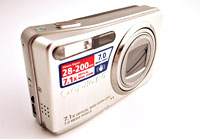 We can’t say we liked this move, as the smaller, recessed power button is much harder to operate (we also had issues with powering up the camera, but we’ll move on to that later).
We can’t say we liked this move, as the smaller, recessed power button is much harder to operate (we also had issues with powering up the camera, but we’ll move on to that later). LCD screen
LCD screen Seeing as the assistant was most unimpressed with our antics we had to cut short our testing, so we can only assume that the differences would manifest themselves under more demanding light conditions or under closer scrutiny.
Seeing as the assistant was most unimpressed with our antics we had to cut short our testing, so we can only assume that the differences would manifest themselves under more demanding light conditions or under closer scrutiny.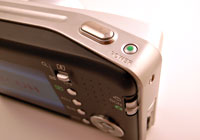 The LCD screen was easy to read (although, being London in September, the sun wasn’t exactly blinding), but we would have liked to have seen an optical viewfinder in there too.
The LCD screen was easy to read (although, being London in September, the sun wasn’t exactly blinding), but we would have liked to have seen an optical viewfinder in there too.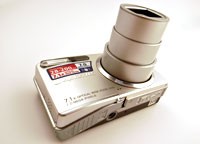 Night time woes
Night time woes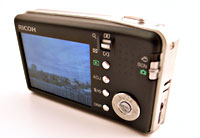 Noisy nights
Noisy nights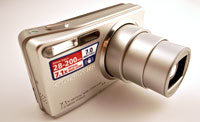 Street photographers looking to grab late night sneaky shots with the camera on 10 second self timer will have to think again too as the flash – yes the FLASH! – blinks brightly on and off during the countdown!
Street photographers looking to grab late night sneaky shots with the camera on 10 second self timer will have to think again too as the flash – yes the FLASH! – blinks brightly on and off during the countdown!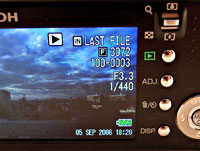 We had some problems with that the SD slot, with a worrying ‘card format’ error popping up unexpectedly halfway through a shoot.
We had some problems with that the SD slot, with a worrying ‘card format’ error popping up unexpectedly halfway through a shoot.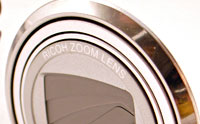 Spot
Spot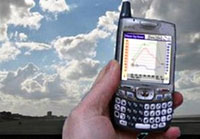 Like most Brits we’re more than a bit obsessed with all things weather-related, so as soon as we bought a Palm Treo we were busily installing a host of weather-related applications, including
Like most Brits we’re more than a bit obsessed with all things weather-related, so as soon as we bought a Palm Treo we were busily installing a host of weather-related applications, including 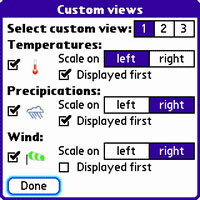 Setting it all up
Setting it all up Wind speeds can be shown in km/h, mph, m/s, knots or in the trusty old Beaufort Scale, with the choice to select temperature readouts in Celsius or old school Fahrenheit.
Wind speeds can be shown in km/h, mph, m/s, knots or in the trusty old Beaufort Scale, with the choice to select temperature readouts in Celsius or old school Fahrenheit.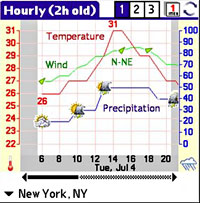 At just €9.95 the program represents great value to our eyes and looks to be an essential purchase for travellers and meteorological mullers.
At just €9.95 the program represents great value to our eyes and looks to be an essential purchase for travellers and meteorological mullers.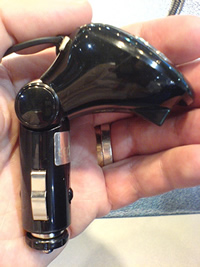 There are a couple of dilemmas for anyone who takes their MP3 player to play in the car. How do you get the sound to the car stereo and how do you stop the thing sliding about all over the place? The TrekStor MP3-RadioStation f.ox tackles these.
There are a couple of dilemmas for anyone who takes their MP3 player to play in the car. How do you get the sound to the car stereo and how do you stop the thing sliding about all over the place? The TrekStor MP3-RadioStation f.ox tackles these.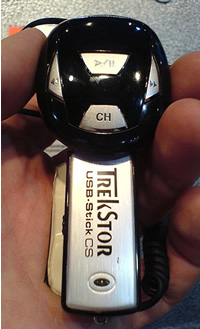 Where do the tunes come from? There’s no storage on board, as the music is supplied via a USB memory stick that plugs in the bottom. This arrangement brings the advantage of low cost expansion and that the music storage is only limited by the size and number of memory sticks you’ve got.
Where do the tunes come from? There’s no storage on board, as the music is supplied via a USB memory stick that plugs in the bottom. This arrangement brings the advantage of low cost expansion and that the music storage is only limited by the size and number of memory sticks you’ve got.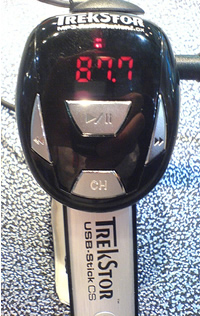 Sadly for UK users, devices like this can’t be used legally, as Ofcom don’t differentiate between low-power gadgets such as this that transmit over a short distance and a full blown radio station.
Sadly for UK users, devices like this can’t be used legally, as Ofcom don’t differentiate between low-power gadgets such as this that transmit over a short distance and a full blown radio station. According to new research from The Diffusion Group, only 14% of broadband households would be interested in an iTunes online movie download service for use on PCs or portable devices if titles were priced at $15 each. This compares to total interest of 23% at $10 per download – a 64% decline in interest when increasing the cost per title by only $5.
According to new research from The Diffusion Group, only 14% of broadband households would be interested in an iTunes online movie download service for use on PCs or portable devices if titles were priced at $15 each. This compares to total interest of 23% at $10 per download – a 64% decline in interest when increasing the cost per title by only $5. Regardless of whether the iTunes movie download service is announced this month or later this year, Greeson believes that the time is right for Apple to enter this market space. “Although current services such as CinemaNow and Movielink continue to languish, Apple is aware that the conditions are now suitable for extending iTunes to include full-length movie downloads. Consumer awareness has improved; video-over-broadband is now viable; studios are now making movies available for online download to DVDs; portable video platforms are improving qualitatively with each new generation; and Apple’s brand awareness and credibility are at all time highs. As well, CinemaNow and Movielink’s experience, while insightful, is of limited value to Apple, who continues to enjoy the fruits of being a market-maker in portable digital electronics and online media services.”
Regardless of whether the iTunes movie download service is announced this month or later this year, Greeson believes that the time is right for Apple to enter this market space. “Although current services such as CinemaNow and Movielink continue to languish, Apple is aware that the conditions are now suitable for extending iTunes to include full-length movie downloads. Consumer awareness has improved; video-over-broadband is now viable; studios are now making movies available for online download to DVDs; portable video platforms are improving qualitatively with each new generation; and Apple’s brand awareness and credibility are at all time highs. As well, CinemaNow and Movielink’s experience, while insightful, is of limited value to Apple, who continues to enjoy the fruits of being a market-maker in portable digital electronics and online media services.”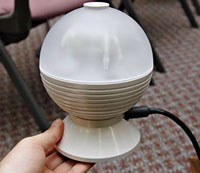 We can’t say we like the thought of being bombarded by different whiffs while we’re listening to the radio, but it seems someone in Japan liked the idea so much that they’re about to launch a fragrance-pumpin’ product in October.
We can’t say we like the thought of being bombarded by different whiffs while we’re listening to the radio, but it seems someone in Japan liked the idea so much that they’re about to launch a fragrance-pumpin’ product in October. The gadget connects to your desktop via USB, with the PC downloading the aroma instructions from the radio station via the Internet, with odorous wafts synchronised to match whatever song is currently being played.
The gadget connects to your desktop via USB, with the PC downloading the aroma instructions from the radio station via the Internet, with odorous wafts synchronised to match whatever song is currently being played. The USB Aroma Geur is available for 49,900 Yen ($430), with the service scheduled to start up in Japan from 2nd October 2006.
The USB Aroma Geur is available for 49,900 Yen ($430), with the service scheduled to start up in Japan from 2nd October 2006. The news that OFCOM is to review its position on Voice Over IP services (VOIP) – the way we can make low cost or free phone and video calls currently from our PC’s generally using call centre-type headsets – is part of the evolution of these types of service from guerrilla geek to middle class mainstream. Now that Tesco’s are marketing VOIP services it’s fair to say that it’s a ‘regular’ service/product.
The news that OFCOM is to review its position on Voice Over IP services (VOIP) – the way we can make low cost or free phone and video calls currently from our PC’s generally using call centre-type headsets – is part of the evolution of these types of service from guerrilla geek to middle class mainstream. Now that Tesco’s are marketing VOIP services it’s fair to say that it’s a ‘regular’ service/product. Prices for the new device are not yet released, but industry observers are talking of a figure around a £100 to make this potentially cost saving purchase.
Prices for the new device are not yet released, but industry observers are talking of a figure around a £100 to make this potentially cost saving purchase. News International, MySpace-Murdoch’s newspaper enterprise yesterday launched a new, free newspaper and Web site for London.
News International, MySpace-Murdoch’s newspaper enterprise yesterday launched a new, free newspaper and Web site for London. Besides the centrally placed Sky adverts, there’s a
Besides the centrally placed Sky adverts, there’s a